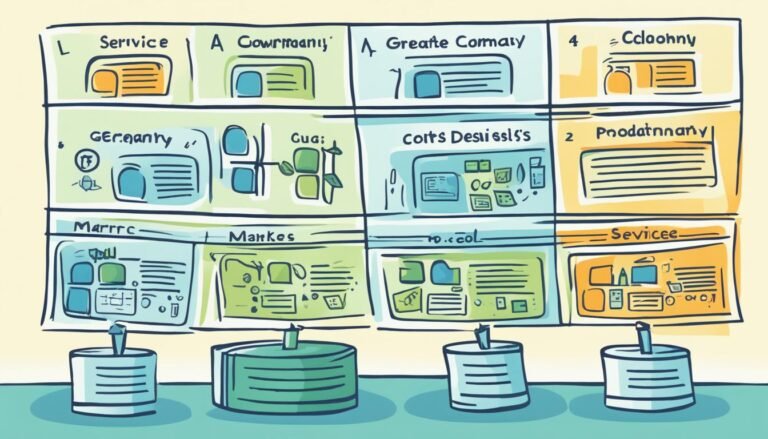Psychology of Customer Retention
Imagine you're in a bustling marketplace, browsing through various stalls filled with colorful merchandise. As you walk past one particular stall, a friendly vendor catches your eye and starts a conversation. They ask about your preferences, recommend products tailored to your taste, and even offer a discount on your first purchase.
Intrigued, you decide to give it a try and make a purchase. Now, think about this scenario in the context of customer retention. What strategies did the vendor use to not only attract you but also keep you coming back for more?
In this discussion, we will explore the psychology behind customer retention and uncover the key factors that contribute to long-lasting customer relationships.
Key Takeaways
- Customer loyalty and satisfaction are essential for businesses as they lead to repeat purchases, trust, and a connection between the customer and the brand.
- Satisfied customers are more likely to become loyal customers, resulting in increased customer retention rates and reduced customer churn.
- Building trust and credibility through consistent delivery on promises, excellent customer service, and transparent communication is crucial for establishing strong customer relationships.
- Actively listening to customer feedback, providing personalized experiences, and showing genuine interest in customers' needs help foster lasting relationships and enhance customer satisfaction.
Importance of Customer Loyalty
Customer loyalty is a vital component of business success, as it not only ensures repeat purchases but also fosters a sense of trust and connection between the customer and the brand.
In today's competitive market, customer satisfaction plays a crucial role in determining the success or failure of a business. Research has consistently shown that satisfied customers are more likely to become loyal customers, leading to increased customer retention rates and reduced customer churn.
Customer satisfaction can be defined as the extent to which a customer's expectations are met or exceeded by a product or service. When customers are satisfied with a brand's offerings, they're more likely to continue doing business with that brand and recommend it to others. This positive word-of-mouth can greatly benefit a business by attracting new customers and expanding its customer base.
On the other hand, customer churn refers to the rate at which customers stop doing business with a company. High customer churn can be detrimental to a business, as it not only leads to lost revenue but also indicates that the brand is failing to meet its customers' needs and expectations.
Understanding Customer Expectations
To effectively understand customer expectations, businesses must delve into the mindset and preferences of their target audience, allowing them to tailor their products and services accordingly. Understanding customer expectations is crucial for achieving customer satisfaction and maintaining long-term loyalty. Research shows that managing expectations is a key driver of customer satisfaction, as customers have certain expectations about the products or services they purchase. When these expectations are met or exceeded, customers are more likely to be satisfied and remain loyal to a brand.
One way businesses can understand customer expectations is by conducting market research and gathering customer feedback. This can be done through surveys, interviews, or focus groups. By analyzing this data, businesses can gain insights into what customers value, what they expect from a product or service, and how they perceive the overall customer experience.
Another important aspect of understanding customer expectations is staying up to date with industry trends and competitors. By monitoring the market and keeping an eye on what competitors are offering, businesses can identify new customer expectations and adapt their offerings accordingly.
Furthermore, businesses should also consider the specific needs and preferences of different customer segments. By segmenting their customer base and tailoring their products and services to meet the unique expectations of each segment, businesses can enhance customer satisfaction and build stronger relationships.
Building Trust and Credibility
To build trust and credibility with your customers, it's crucial to establish strong relationships. This can be achieved by consistently delivering on your promises, providing excellent customer service, and being transparent in your communication.
Additionally, enhancing your perceived expertise through showcasing your knowledge and industry experience can further instill confidence in your customers.
Lastly, leveraging social proof, such as positive testimonials and reviews, can serve as powerful evidence of your reliability and credibility, helping to strengthen the trust you have built with your customers.
Establishing Customer Relationships
Establishing strong customer relationships is crucial for businesses to gain trust and credibility, ensuring long-term success and customer satisfaction. To achieve this, businesses must focus on establishing rapport and fostering connections with their customers.
Research shows that customers are more likely to remain loyal to a brand when they feel a personal connection and trust the company. Building trust involves consistent communication, delivering on promises, and being transparent about the company's values and practices. By actively listening to customer feedback and addressing their concerns promptly, businesses can demonstrate their commitment to customer satisfaction.
Additionally, providing personalized experiences and showing genuine interest in customers' needs can help create lasting relationships. Ultimately, businesses that prioritize building strong customer relationships won't only enhance customer loyalty but also attract new customers through positive word-of-mouth recommendations.
Enhancing Perceived Expertise
Building trust and credibility is essential in enhancing perceived expertise when it comes to establishing strong customer relationships. Customers are more likely to trust and rely on businesses that they perceive to be experts in their field. Here are four ways to enhance credibility and expertise perception:
- Display industry knowledge: Demonstrate your expertise by sharing valuable insights, trends, and information related to your industry. This can be done through blog posts, newsletters, and social media content.
- Provide exceptional customer service: Delivering exceptional service consistently shows that you're dedicated to meeting customer needs and solving their problems. This builds trust and enhances your perceived expertise.
- Showcase customer testimonials and case studies: Highlighting positive customer experiences and success stories can help potential customers see the value and expertise your business offers.
- Collaborate with industry influencers: Partnering with respected influencers in your industry can boost your credibility and expertise perception. Their endorsement can lend credibility to your brand and attract more customers.
Leveraging Social Proof
Leveraging social proof is a powerful strategy for businesses to establish trust and credibility with their customers. Social validation, in the form of testimonials and reviews, can significantly impact a customer's perception of a brand.
Research has shown that people are more likely to trust a product or service when they see positive feedback from others who've already made a purchase. Testimonial marketing, where satisfied customers share their experiences and endorse a brand, can be a highly effective way to leverage social proof.
The Role of Emotional Connection
Emotional connection plays a crucial role in customer retention, shaping their loyalty and influencing their decision-making process. When customers feel emotionally connected to a brand, they're more likely to stay loyal and continue to engage with the company's products or services. This emotional bonding goes beyond customer satisfaction and creates a deeper connection that's difficult for competitors to replicate.
Here are four ways in which emotional connection impacts customer retention:
- Enhanced trust: When customers feel emotionally connected to a brand, they develop a sense of trust. They believe that the brand understands their needs and values their satisfaction. This trust strengthens the relationship and encourages customers to stay loyal.
- Increased brand advocacy: Emotional connection generates a sense of belonging and identification with the brand. Customers who feel emotionally connected are more likely to become brand advocates, recommending the company to friends and family. Their positive experiences and emotional attachment drive customer retention.
- Higher customer lifetime value: Emotionally connected customers tend to have a higher lifetime value. They're more likely to make repeat purchases and spend more money with the brand over time. This increased customer lifetime value contributes to the overall profitability and success of the business.
- Resilience to price competition: Emotional connection creates a unique bond between the customer and the brand, making them less sensitive to price changes. Customers who feel emotionally connected are willing to pay a premium for the brand's products or services, reducing their susceptibility to competitive offerings.
Effective Communication Strategies
To effectively retain customers, clear messaging is crucial. By providing concise and easily understandable information, you can ensure that your customers fully comprehend your offerings.
Additionally, tailoring your communication approaches to suit individual customer needs and preferences can foster stronger connections and increase customer loyalty.
Lastly, building trust through effective communication is key. By being transparent, responsive, and consistently delivering on promises, you can establish a foundation of trust that encourages long-term customer relationships.
Clear Messaging for Retention
Effective communication strategies play a crucial role in ensuring clear messaging for customer retention, fostering strong relationships, and maximizing long-term loyalty. By implementing clear messaging techniques, businesses can improve retention rates and keep customers engaged.
Here are four strategies to help you achieve clear messaging for customer retention:
- Use simple and concise language: Avoid jargon and complex terminology that may confuse customers. Opt for clear and straightforward communication to ensure your message is easily understood.
- Personalize your communication: Tailor your messages to individual customers based on their preferences, behavior, and past interactions. This personalized approach makes customers feel valued and enhances their connection with your brand.
- Provide consistent messaging across all channels: Maintain a consistent tone, voice, and messaging across different platforms and channels. This consistency helps reinforce your brand identity and ensures a cohesive customer experience.
- Use visuals and multimedia: Incorporate visuals, videos, and infographics to complement your messaging. Visual content can help convey complex information more effectively and capture customers' attention.
Tailored Communication Approaches
Building on the foundation of clear messaging, businesses can further enhance their customer retention efforts through tailored communication approaches that effectively engage and resonate with individual customers.
Tailored communication techniques involve crafting messages and delivering them in a way that aligns with each customer's preferences, needs, and behaviors. By implementing targeted messaging, businesses can personalize their interactions with customers, making them feel understood and valued.
Research has shown that personalized communication leads to higher customer satisfaction and loyalty. For example, using customer data and segmentation techniques, businesses can send customized emails or offers that address specific interests or purchasing patterns.
Additionally, personalized communication can extend to social media interactions, chatbots, and customer service interactions, ensuring a seamless and consistent experience across various touchpoints.
Building Trust Through Communication
Businesses can establish trust and foster stronger relationships with their customers by employing effective communication strategies. Building trust through communication is crucial for customer retention. Here are four effective strategies to achieve this:
- Active listening: Show genuine interest in your customers by actively listening to their concerns, needs, and feedback. This demonstrates that you value their opinions and are committed to addressing their needs.
- Transparency: Be open and honest in your communication. Share relevant information about your products, services, and company policies. This helps build trust and credibility with your customers.
- Personalization: Tailor your communication to each customer's preferences and needs. Use their preferred channels and address them by name. This personalized approach shows that you value their individuality and strengthens the connection between you.
- Prompt and proactive communication: Respond promptly to customer inquiries, concerns, and feedback. Be proactive in reaching out to customers to provide updates, offer assistance, or resolve issues. This demonstrates your commitment to their satisfaction and builds trust in your reliability.
Personalization and Customization
Personalization and customization play a pivotal role in fostering strong customer relationships and driving long-term loyalty. In today's competitive market, understanding and catering to customer preferences is crucial for businesses to stay ahead. Personalized marketing is an effective strategy that allows companies to tailor their offerings and messages to individual customers, ultimately enhancing their overall experience.
Research shows that customers appreciate personalized experiences. According to a study conducted by Epsilon, 80% of consumers are more likely to make a purchase when brands offer personalized experiences. By analyzing customer data and utilizing techniques like segmentation and targeting, businesses can create tailored marketing campaigns that resonate with their audience. This not only increases the likelihood of conversion but also cultivates a sense of loyalty and satisfaction among customers.
Personalization goes beyond just addressing customers by their names. It involves understanding their preferences, behaviors, and needs and using this information to provide relevant and valuable content. For example, Netflix's recommendation system uses algorithms to analyze users' viewing history and preferences to suggest personalized movie and TV show recommendations. This personalized approach not only makes the user experience more enjoyable but also keeps customers engaged and coming back for more.
Providing Exceptional Customer Service
To create a holistic customer experience, businesses must prioritize providing exceptional customer service that goes beyond personalization and customization. Exceptional customer service is crucial for customer retention as it not only satisfies customers' needs but also builds trust and loyalty.
Here are four key strategies to provide exceptional customer service:
- Actively seek and listen to customer feedback: Encourage customers to provide feedback through surveys, social media, or direct interactions. This valuable feedback helps businesses understand their customers' needs, preferences, and pain points, allowing them to tailor their services accordingly.
- Respond promptly and effectively to customer inquiries and complaints: Timely and efficient responses to customer inquiries and complaints demonstrate a commitment to resolving issues and providing satisfactory solutions. Prompt service recovery can turn a dissatisfied customer into a loyal advocate for your brand.
- Empower employees to go above and beyond: Provide employees with the authority and resources to make decisions and resolve customer issues independently. This empowers them to provide exceptional service and create memorable experiences for customers.
- Continuously train and educate employees: Invest in ongoing training and development programs to enhance employees' knowledge and skills in customer service. Well-trained employees are better equipped to handle challenging situations, anticipate customer needs, and deliver exceptional service consistently.
Rewarding and Recognizing Customer Loyalty
Rewarding and recognizing customer loyalty is crucial for maintaining a strong customer base.
Loyalty program benefits, such as exclusive discounts, freebies, and personalized rewards, can incentivize customers to continue their patronage.
Additionally, implementing personalized recognition strategies, such as sending personalized thank-you notes or offering special privileges to long-term customers, can make them feel valued and appreciated, fostering a deeper sense of loyalty.
Loyalty Program Benefits
By implementing a well-designed loyalty program, businesses have the opportunity to foster stronger connections with their customers and encourage repeat purchases. Loyalty programs are an effective customer retention strategy for several reasons:
- Increased customer engagement: Loyalty programs provide a platform for businesses to engage with their customers on a regular basis. By offering exclusive rewards and personalized offers, businesses can keep customers actively involved and interested in their brand.
- Enhanced customer loyalty: When customers feel appreciated and rewarded for their loyalty, they're more likely to continue purchasing from the same business. Loyalty programs help build a sense of loyalty and trust between the customer and the brand.
- Higher customer lifetime value: Loyalty programs can significantly increase customer lifetime value, as they incentivize customers to make repeat purchases. By offering incentives and rewards, businesses can encourage customers to spend more and increase their overall lifetime value.
- Competitive advantage: A well-designed loyalty program can give businesses a competitive edge in the market. Customers are more likely to choose a brand that offers rewards and benefits for their loyalty, over those that don't have a loyalty program in place.
Personalized Recognition Strategies
With the foundation of a well-designed loyalty program in place, businesses can now explore personalized recognition strategies to further reward and acknowledge customer loyalty.
Personalized recognition strategies play a crucial role in enhancing customer satisfaction and increasing customer retention. Research has shown that customers who feel recognized and valued are more likely to continue doing business with a company.
Implementing personalized recognition strategies allows businesses to demonstrate their appreciation for their loyal customers, creating a sense of connection and fostering a long-term relationship. These strategies can include personalized thank-you notes, birthday or anniversary rewards, exclusive offers based on customer preferences, and personalized recommendations.
Creating a Seamless Customer Experience
To create a seamless customer experience, businesses must prioritize understanding and meeting the needs and expectations of their customers. This involves creating meaningful interactions and streamlining the customer journey. Here are four key strategies to achieve this:
- Develop a customer-centric mindset: Put yourself in your customers' shoes and understand their pain points, desires, and motivations. This will allow you to tailor your products, services, and processes to better meet their needs.
- Implement omni-channel communication: Customers now expect to interact with businesses through a variety of channels such as websites, social media, email, and phone. Ensure a consistent and seamless experience across all channels by integrating them and providing quick and efficient responses.
- Personalize the customer experience: Leverage customer data to personalize interactions and deliver relevant content. By understanding their preferences and purchase history, you can offer targeted recommendations, exclusive offers, and personalized messages.
- Continuously improve and optimize: Regularly collect feedback from customers to identify areas for improvement. Use this feedback to enhance the customer journey, remove pain points, and exceed expectations.
Measuring and Monitoring Customer Retention Success
Measuring and monitoring customer retention success reveals valuable insights into the effectiveness of your business's efforts in building long-term customer relationships. It allows you to assess the impact of your customer retention strategies and identify areas for improvement.
One crucial aspect of measuring customer retention success is evaluating customer satisfaction. By measuring customer satisfaction, you can gauge how well your business is meeting customer expectations and identify any gaps in your service delivery.
There are several methods to measure customer satisfaction, including surveys, interviews, and feedback forms. These tools enable you to gather quantitative and qualitative data on customer experiences and perceptions. By analyzing this data, you can identify patterns, trends, and areas where customers are most satisfied or dissatisfied. This information can then be used to refine your customer retention strategies and tailor your offerings to better meet customer needs.
Monitoring customer retention success also involves tracking customer loyalty and repeat purchase behavior. By analyzing customer behavior data, such as purchase frequency and average order value, you can identify your most loyal customers and measure their retention rate over time. This information can help you identify the key factors that contribute to customer loyalty and inform your efforts to retain and engage customers.
Conclusion
In conclusion, understanding the psychology of customer retention is crucial for businesses to thrive in today's competitive market. Research shows that acquiring a new customer can be up to five times more expensive than retaining an existing one.
This statistic highlights the significance of customer loyalty and the need to focus on building strong relationships with customers. By meeting their expectations, building trust, and providing exceptional service, businesses can create an emotional connection that leads to long-term customer retention and ultimately, business success.







